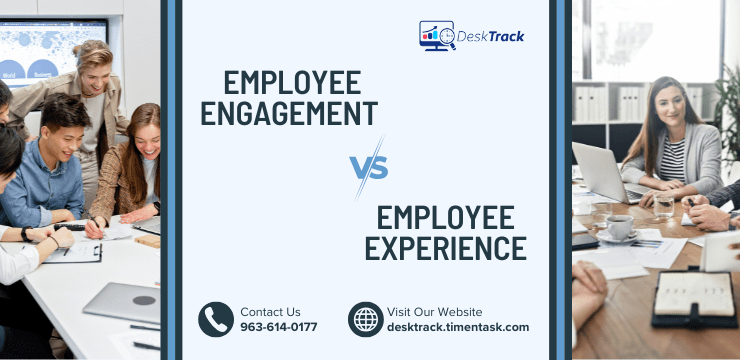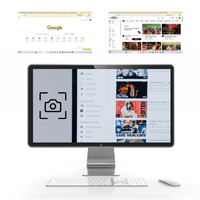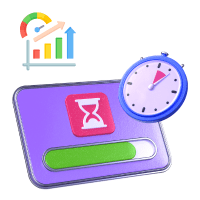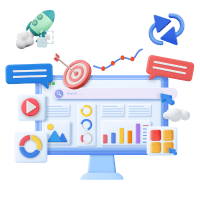
Employee engagement vs. employee experience. How did we get to this point? Both experience and engagement are essential for the growth, development, and productivity of your employees. Plus, although individuals and sometimes even experts use these terms interchangeably, both are quite different.
Without team engagement, there is no experience. Both of these aspects are interrelated for sure. Thus, they need to be measured and, if required, improved for the betterment of your employees and your organization as a whole. However, you also need to do it the right way and balance both engagement and experience for employees.
So, today, we have the most accurate and insightfully detailed employee engagement vs. employee experience debate for you. At the end of the blog, you will have the best way to keep your employees dedicated and inspired to keep working for you and provide you with the best outcomes.
What is Employee Engagement?
Make your workday more productive
Time tracking and work management can help you reach your goals
faster.
Employee engagement is the dedication, commitment, and work enthusiasm levels of your employees and teams towards your organization. Here, you need to wrap your head around these key aspects for maximizing engagement.
1. Emotional Commitment
It is essential to realize the emotional or affective dedication of your staff. We found that engaged employees are affectionate towards their work. So, they give their time and heart to every task.
2. Effective management
According to a survey by Gallup, 70% of team engagement is because of how the manager handles employees, including their concerns. In short, the more skilled the manager, the higher the engagement.
3. Aligned Objectives
If your teams are engaged with your organization, they understand the clarity of your objectives and start sharing your vision. That is, they try harder and harder to assist you in completing your long-term goals with every task. That’s because employees:
- Feel that their efforts contribute more to your mission and vision
- This makes a sense of belonging and purpose within the organization
4. Active Participation & Autonomy
Employees must get the authority for active participation and autonomy. When team members get the trust and empowerment to start and make decisions, they feel more included in their job roles and work outcomes. In short, highly engaged team members have more opportunities to:
- Bring fresh and innovative ideas.
- This is even applicable to their routine tasks.
- This way, employees consistently work to achieve more excellence
Read Also: 15 Productivity Tips for Small Businesses: Must-Know Hacks & Strategies
What are Some Fun Employee Engagement Activities for Modern Teams?

If you are running a modern business with modern teams and still boosting team engagement through standard, bland methods, it’s not going to work as expected. Instead, try these for a better engagement and productivity-boosting change.
- Fika Breaks: These are simply 10-30 minute beverage breaks where you do anything but work.
- Energy Mapping: Planning around the highs and lows of an individual’s productivity.
- Retreats: Great opportunities for employees to learn, bond, and create together. However, if you plan to get some RoI out of it, then it can backfire.
- Solution-Oriented Discussions: Employees can discuss solutions to real issues. This boosts engagement
- Team Volunteering Activities: Identify your employees’ concerns for social causes and contribute to them. You can even give them paid time off for volunteering for community services.
- Professional Development: As per an expert report, it’s one of the best ways to boost employee engagement
- Light-hearted Internal Communications: For example, you can let your employees and teams share fun memes, GIFs, etc. However, don’t overdo it.
- Fun Onboarding Experiences: For instance, show new hires what it is like to work for you.
- Consistent Recognition: Consistently recognize the good work performance of your employees via incentives.
- Mindfulness Sessions: It’s the best way to relieve stress and improve mental health for maximizing employee engagement.
- Awards: Everyone can get awards and recognition, including tangible perks, like gift cards. You can even give away spoof awards like most fashionable employee of the month or year.
- Incentive-Based Objectives: Employees can even get recognition and rewards for completing objectives or reaching a particular work milestone.
What is Employee Experience?
Employee experience comprises their entire journey through your workplace. That is, everything between onboarding and offboarding. Many aspects impact it, including interpersonal bond quality, leadership style, and opportunities for professional development. However, these 3 key components play an essential part.
1. Physical Experience
Physical experience includes all the sensory aspects within your workplace atmosphere. For instance, office infrastructure, noise levels, furniture comfort, etc. These directly impact their productivity and energy levels and influence how employees feel about:
- Their work
- Your organization
2. Digital Experience
When we talk about digital experience, it includes all the technology and tools your teams and employees use. It is essential to provide innovative and efficient tools for:
- Communication
- Accessing resources
- Team connection maintenance
3. Cultural Experience
Cultural experience is all about your workplace and its culture. This includes the daily behavior and values. These are the inseparable elements that separate good workplaces from great workplaces.
How to Jot Employee Journey for a Better Experience?
To understand the meaning of employee experience and enhance it, you need to map the journey of your employees from onboarding to offboarding.
It’s all about reviewing the employee life cycle and evaluating the experience at each stage to improve with real-time employee monitoring software. The aim here is to ensure that your employees and teams are highly engaged throughout.
Remember that disengagement at candidacy, onboarding, performance, growth, and/or exit worsens the team experience. For the same, we can include some employee-centric questions such as:
During Candidacy:
- Do you feel treated fairly and equally?
- Have your contacts from us lived by the values?
- Have you had a positive experience with the meeting places, technology, and tools used through the process?
During Onboarding:
- Do you know how to use the various technologies and tools we rely on?
- Have you been made to feel a part of the team?
- Do you know where you can get the support and resources you need?
- Do you know what we expect from you?
During Performance:
- Do you feel that you are receiving enough feedback?
- How often are you meeting for a one-to-one meeting with your line manager?
- Do you feel supported and encouraged by those around you?
- Do you feel that you are a part of a well-functioning team?
During Growth:
- Do you feel that you have fair and equal access to development opportunities?
- Is your physical and mental well-being being supported during periods of stretch and learning?
- Do you have access to the tools and technology required to develop?
During Exit:
- Did you get enough value for the work you have done for us?
- Do you feel that sufficient measures were put in place to ensure you had a good experience with us?
- Were you equally treated throughout your employee journey?
Why are People Focusing on Employee Experience?
Businesses worldwide are focusing on enhancing employee and team experience. This even includes big names, such as Amazon, Sports Direct, and Google. Why wouldn’t they? It’s very rewarding in itself as you get:
- 2.5 times greater revenue growth
- 2 times the annual net income
- 62% fewer accidents
- 50% fewer absent days
- 40% lower employee turnover
- 24% higher net promoter score
- 18% higher productivity
- 12% higher customer advocacy
What are the 4 Key Differences Between Employee Engagement vs. Employee Experience?
You can utilize your time understanding the multiple differences between employee engagement and experience. However, that will only confuse you and will be time waste. The better way is to just wrap your head around these 4 aspects.
| Aspect | Employee Engagement | Employee Experience |
| Scope | Employee’s commitment level to their tasks and/or job roles | From onboarding to offboarding |
| Timeframe | It’s static. Engagement refers to a specific moment where staff members are either engaged or disengaged | It’s flexible. Experience links past interactions with current scenarios to forecast future behaviors over extended periods |
| Responsibility | Managerial efforts | The responsibility is shared and delegated among senior leaders, HR professionals, and others, encapsulating job design, incentives, and work cultures. |
| Measurement | Measured through surveys that focus on satisfaction, commitment, and alignment with organizational objectives | Measured via ongoing feedback, touchpoints across the entire employee journey, and overall sentiment about the organizational atmosphere |
How to Measure Employee Engagement vs. Employee Experience?
To improve anything, you need to measure it first. This also includes employee experience and employee engagement. Fortunately, measuring the level of these crucial aspects is much simpler than you think:
1. Utilize Employee Engagement Surveys
The idea is to look for specific keywords in employee engagement surveys. For instance, positive culture. Now, all you have to do is either manually or with a specific tool, analyze the meaning and context behind these keywords.
2. Evaluate Employee Life Cycle
As we mentioned before, you need to analyze every stage of the employee life cycle, including candidacy, onboarding, performance, growth, and offboarding. Moreover, if at any stage you find low experience, then you need to find its cause and eliminate it.
3. Evaluate HR Metrics
Let’s get straight to an example. For instance, if the employee retention rate in your organization is always high, then your employees feel valued and are inclined to stay for longer. On the other hand, high turnover rates indicate that the experience of your employees with it is not great.
4. Measure Frequently
The organizational experience of your employees can change at any stage. For example, the onboarding experience may have been good. However, she or he might face issues during the growth stage. You may know everything, but you will never identify these patterns with only annual surveys.
5. Openly Communicate with Employees
It is 100% possible for your employees to hide the truth in surveys. This can be due to the fear of bad or micromanagers. That’s why it’s essential for you not to completely rely on surveys and to openly communicate with your staff. Otherwise, you could be losing potential high-performing team members.
6. Pay Attention to Onboarding
The first 90 days of your new hires mould their perspective about you and your organization. So the experience over these days must be excellent. It should also be an honest experience. You know what we mean. Right?
How Does Employee Engagement Influence Employee Experience?
The level of employee engagement in your organization, staff behavior, and mindset at each workday has a major influence on what they think about you and your workplace. Did you know that globally, only 15% of employees are engaged at work? In the USA, that’s 33%. Although highly engaged organizations have a competitive edge, as they can get more output from their employees, the facts say different.
- Only 3 out of 10 employees agree that they have the resources and tools required to do their work right.
- Only 4 in 10 employees agree that they have the opportunity to do what they do best every day, when they are at work.
- Only 3 in 10 team members agree that they have been recognized in the last 7 days.
We also strongly agree that workplaces with high levels of team engagement provide an excellent experience to their employees, as they decide to stay for longer.
Which is More Important Between Employee Engagement vs. Employee Experience?
So, what’s more crucial between employee engagement and employee experience? The answer is both. Simply put:
- Employee engagement measures provide us with the what part.
- On the other hand, employee experience tells you why something was good or bad for the employee.
So, here in the employee experience vs. engagement, both stand equal as both these aspects are essential to understand how much effort your employee will be, is, and can put into her or his work.
Read Also: Top 15 Employee Time Recording Software & Apps in 2025
How to Improve Employee Engagement vs Employee Experience?
Did you know that you can lose around 9 trillion dollars due to low employee experience and engagement? That’s around 10% of global GDP. However, you already know that we won’t let this happen to you:
1. Act on Feedback
Feedback forms and surveys are not meant to be filled out once and then collect dust as they pile up. You need to act on them, too. If something is wrong in your organization, accept and change it. However, you can’t overdo it. The rule is that every solution must be 50% in your favor and 50% in your employees’ favor.
2. Employee Recognition is Key
The more recognition your employees get, the more dedicated they will be towards their work and tasks. It’s as simple as that.
3. Provide the Right Tools
When will your employees work if they are complaining about not having the required resources all the time? It’s essential to provide your employees with all the right tools and equipment to ensure streamlined workflows, high engagement, and high productivity.
4. Promote Work-Life Balance
A good balance between work and personal life without compromising the quality of any one is essential for your employees. A good idea is to use employee scheduling software to make schedules that compromise on neither.
5. Keep Employees Psychologically Safe
A lot is going on in your employees’ lives. You might not even get a hint, as employees will always bring their smiling faces to work. Not their fault, as they were always told to never mix personal and professional lives. Thus, you must look out for any signs of stress and burnout. For instance:
- An employee constantly feeling lost in meetings is probably experiencing some kind of trouble at home.
- Openly conversing will always help provide the perfect solution.
6. Provide Professional Development Opportunities
An employee stuck in the same position for a long time will not be highly engaged at work. Simply put, the work gets boring as there is no challenge. Thus, you must open doors to professional growth for your employees at every chance you get.
7. Implement Health Programs
It’s also essential for you to implement annual, weekly, and/or monthly health and well-being programs in your organization. This helps your employees stay productive, rejuvenated, and always provides you with the best of their skills.
8. Compile the Right Questions
Pulling the truth out of your employees about how engaged they are at work or how their experience is so far is simple. All you have to do is frame the right questions. For instance:
- How could your first day have been improved?
- How would you rate your work-life balance?
- Do you feel like you belong with us?
- What are the 3 words you would use to describe us?
- What do you like the most about us?
- How satisfied are you with us?
- To what extent do you see yourself growing and developing with us?
- Has your manager ever discussed learning and development opportunities with you?
- How are you challenged in your current role?
9. Establish A Positive Work Culture
As we mentioned before, you need to create an all-inclusive work culture in your organization. Businesses that have such environments experience higher retention rates as employees feel equally valued and involved.
How to Boost & Balance Employee Engagement vs. Employee Experience with DeskTrack?
Boosting and balancing employee engagement vs. experience can be even simpler when there is hardly any manual effort going into it. That’s because you are using the best time tracking software.
With DeskTrack, you get a plethora of features and functionalities that not only help you spot and eliminate low team engagement but also boost employee efficiency and productivity. Here’s how it all works.
- You get the screenshot monitoring feature for identifying employee pain points.
- Too much idle time is a possibility of the employee being drained and in need of a break.
- With the real-time activity tracking feature, you can identify employees who are randomly browsing non-useful URLs, apps, and files. This is a clear case of work disengagement and boredom.
- Similarly, with the task and project management feature, spotting disengaged employees and teams is just one click away.
Conclusion
Now, we hope that you are clear about all you need to know about the difference between employee engagement vs. employee experience. As a final word, we can say that experience and engagement are two different aspects that are often used interchangeably. However, that’s not how it should be. Your employees must have a good experience working in your organization with a high engagement rate for higher retention and lower staff turnover. Plus, the higher the engagement, the better the employee efficiency and productivity. What’s more is that with DeskTrack, you get the most intuitive features to boost employee efficiency, improve time management, and productivity by identifying pain points and elements of work disengagement in real-time and eliminating them at the earliest.
Frequently Asked Questions (FAQ)
Q. What are the 4 Areas of Staff Engagement?
Ans. Employee engagement is broadly categorized into these key areas.
- Emotional engagement
- Cognitive engagement
- Behavioral engagement
- Social engagement
Q. What are the 3 Stages of Employee Engagement?
Ans. Your team members are either fully engaged, not engaged, or actively disengaged.
Q. Which are the Top 5 Drivers of Employee Engagement?
Ans. These factors define how engaged and dedicated your employees are towards their work and your organization. These aspects decide the connection, motivation, and commitment of your employees towards your workplace. These include:
- Leadership quality
- Meaningful communications
- Recognition
- Growth opportunities
- A positive work culture
Q. What are the 5 Cs in Employee Engagement?
Ans. Working on maximising these is the key to high team engagement.
- Care
- Connect
- Contribute
- Coach
- Congratulate
Q. What is the Difference Between Employee Experience & Engagement?
Ans. The primary difference in employee experience and engagement is that the former is what you think. For instance, what your employees see, feel, and hear in their daily work lives. On the other hand, the latter is what employees feel as an outcome.










